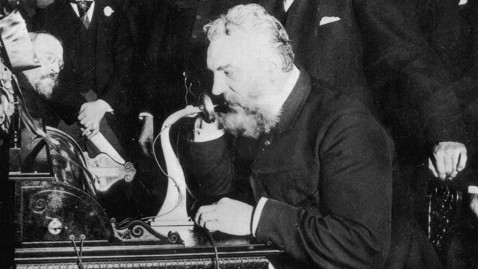Voice of Alexander Graham Bell Heard in Recovered Audio Recording
Not many years ago, scientists developed breakthrough methods to uncover sound from some 100-plus -year-old recordings, giving us the chance to hear audible snippets from as early as 1860. Through this technology now comes perhaps the most intriguing sample yet: an actual recording of the voice of the man credited with inventing the telephone, Alexander Graham Bell.
The recording, a wax-and-cardboard disc, contains the voice of Bell counting aloud, rattling off different percentages and dollar figures, and stating his name, date and address.

Image credit: Fox Photos/Getty Images
"This record has been made by Alexander Graham Bell in the presence of Dr. Chichester A. Bell on the 15th of April, 1885, at the Volta Laboratory, 1221 Connecticut Avenue, Washington D.C.," the inventor declared.
"In witness whereof, hear my voice, Alexander Graham Bell."
Carl Haber, senior scientist in the physics division of Lawrence Berkeley National Laboratory at the University of California, told ABC News that the National Museum of American History has actually been in possession of the Volta Laboratory collection of recordings for years.
"They've had this collection since the 1880s. Their assessment was that it was so delicate that they wanted to sit on it until someone could look at it without damaging it," Haber said.
"In some cases, we're not sure how [these recordings] were played back at the time," said Haber. "Superficially, a lot of these discs look like something you could put a needle to, and you might get some sound."
He said, however, that many of these recordings of various formats were fragile and some already cracked.
The process the Berkeley lab uses to examine these recordings in a gentle way involves a type of high resolution 3-D camera. The technology was originally created to play and digitally transfer modern records "noninvasively," or without a needle.
Carlene Stephens, the curator of these early records at the National Museum of American History, first learned of Haber's innovations and contacted his laboratory in 2011 about the possibility of recovering sound from a portion of the 200 artifacts in the Volta collection.
"We basically pick about 10 percent of the recordings to do a sort of pilot study to uncover sound," Haber explained. He said the recording of Bell's voice was identified by inscriptions during a cataloging process the museum was undertaking, making it immediately appealing to both the museum and the Berkeley lab.
"It's pretty badly broken, it basically looks like a jigsaw puzzle. So, even if this wasn't Bell, this would have been a great example to examine," said Haber.
READ: Solar Plane Makes Last Test Flight Before 'Across America' Trip
As for Bell's counting and speaking aloud of all those numbers in the recording, Haber speculates that early ideas of sound recording were different from what we might think now.
"In those days of Edison and Bell, they thought recording was going to be important for accounting purposes or keeping business records. They may not have originally considered recording music," he said.
Haber's lab in Berkeley has already examined and pulled sound from 9 recordings of the Volta collections, with a few more still in the works. The various formats range from materials like plaster, paper, metal, foil, waxes and differ in shape and size.
In regards to moving forward with examining the full collection from Volta, Haber said that the idea sounds good to him. He's hoping that the release of samples as interesting as the one containing Bell's voice will raise awareness and possibly increase the desire and funding for projects like these.